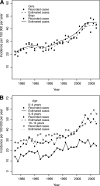Thirty years of prospective nationwide incidence of childhood type 1 diabetes: the accelerating increase by time tends to level off in Sweden
- PMID: 21270269
- PMCID: PMC3028358
- DOI: 10.2337/db10-0813
Thirty years of prospective nationwide incidence of childhood type 1 diabetes: the accelerating increase by time tends to level off in Sweden
Abstract
Objective: During the past few decades, a rapidly increasing incidence of childhood type 1 diabetes (T1D) has been reported from many parts of the world. The change over time has been partly explained by changes in lifestyle causing rapid early growth and weight development. The current study models and analyzes the time trend by age, sex, and birth cohort in an exceptionally large study group.
Research design and methods: The present analysis involved 14,721 incident cases of T1D with an onset of 0-14.9 years that were recorded in the nationwide Swedish Childhood Diabetes Registry from 1978 to 2007. Data were analyzed using generalized additive models.
Results: Age- and sex-specific incidence rates varied from 21.6 (95% CI 19.4-23.9) during 1978-1980 to 43.9 (95% CI 40.7-47.3) during 2005-2007. Cumulative incidence by birth cohort shifted to a younger age at onset during the first 22 years, but from the birth year 2000 a statistically significant reversed trend (P < 0.01) was seen.
Conclusions: Childhood T1D increased dramatically and shifted to a younger age at onset the first 22 years of the study period. We report a reversed trend, starting in 2000, indicating a change in nongenetic risk factors affecting specifically young children.
Figures


Comment in
-
Comment on: Berhan. Thirty years of prospective nationwide incidence of childhood type 1 diabetes: the accelerating increase by time tends to level off in Sweden. Diabetes 2011;60:577-581.Diabetes. 2011 Sep;60(9):e25. doi: 10.2337/db11-0899. Diabetes. 2011. PMID: 21868789 Free PMC article. No abstract available.
References
-
- DIAMOND Project Group Incidence and trends of childhood type 1 diabetes worldwide 1990-1999. Diabet Med 2006;23:857–866 - PubMed
-
- Patterson CC, Dahlquist GG, Gyürüs E, Green A, Soltész G, EURODIAB Study Group Incidence trends for childhood type 1 diabetes in Europe during 1989-2003 and predicted new cases 2005-20: a multicentre prospective registration study. Lancet 2009;373:2027–2033 - PubMed
-
- Dahlquist G, Mustonen L, Swedish Childhood Diabetes Study Group Analysis of 20 years of prospective registration of childhood onset diabetes time trends and birth cohort effects. Acta Paediatr 2000;89:1231–1237 - PubMed
-
- Patterson CC, Dahlquist G, Soltész G, Green A, EURODIAB ACE Study Group. Europe and Diabetes Is childhood-onset type I diabetes a wealth-related disease? An ecological analysis of European incidence rates. Diabetologia 2001;44(Suppl. 3):B9–B16 - PubMed
-
- Substudy EURODIAB, EURODIAB Substudy 2 Study Group Rapid early growth is associated with increased risk of childhood type 1 diabetes in various European populations. Diabetes Care 2002;25:1755–1760 - PubMed
Publication types
MeSH terms
LinkOut - more resources
Full Text Sources
Medical
Miscellaneous

